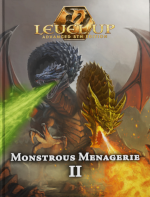Let’s say you’re a D&D character with secondary casting ability, like a paladin, ranger, eldritch knight, arcane trickster, or even a character with the arcane initiate feat. You only have a few low-level spell slots, and your spell save DC is probably not that high because it’s based on your second or third best ability score.
Which of your attack spells will still be useful at high level? Which will drift into irrelevancy?
The highest level monsters tend to have high strength, constitution, and even charisma, as befits the biggest, baddest, and most fearsome monsters in the world. But as monsters get bigger, they don’t get much more nimble, smart, or wise.
If I were really committed to data, this is where I’d have a graph of all six monster attributes from CR 1/8 to 30. It’s too tiresome to do that. But I will go to the trouble of coming up with attribute averages for epic monsters.
The average attributes for the 12 epic-level non-dragon monsters, from the CR 17 Death Knight to the CR 30 Tarrasque, are
Let’s say you’re a high level paladin with a spell DC of 16 and a spell attack of +8. As a group, the epic-level monsters will frequently weather your constitution-based spells (55% of the time) and your spell attacks (60% of the time) but will rarely avoid your dexterity-based spells (only making their saving throw 35% of the time) or wisdom-based spells (40% of the time).
When you throw dragons in the mix, the pattern is even more pronounced. The average attributes of the ancient chromatic dragons are
So the dragons will beat your constitution-based spell 60% of the time and your spell attacks 55% of the time but a dexterity-based spell only 25% of the time and a wisdom-based spell 35% of the time.
So because monster Dexterity doesn’t scale much, dexterity-based spells rule, right? The only problem is, most dexterity spells are direct hit-point damage spells, and monster hit points scale very well. Your dragon will probably miss its save against your Burning Hands but barely notice its effects.
Therefore, an interesting class of spells are those that require Dex saves and have non-damage effects. Highlights of this category include:
Faerie Fire: all attacks against the target have advantage for a minute! My Druidic arcane initiate character uses this spell. A+ would learn again
Grease and Sleet Storm: creatures fall prone! Good for arcane tricksters and eldritch knights, though neither are from their preferred magic schools.
Web and Evard’s Black Tentacles: creatures are restrained until they take an action to break free with a different attribute check. Again, good for arcane tricksters or eldritch knights though not from preferred schools.
Wisdom-based attack spells are also good for dabblers, and there are a ton of low-level, non-damage spells that require a wisdom save. Highlights include:
Command: make the opponent do something stupid. Good for paladins.
Compelled Duel: monster has disadvantage attacking anyone but you, allied attacks end. Good for paladins.
Tasha’s Hideous Laughter: incapacitates, save ends. On brand for arcane tricksters.
Wrathful Smite: frightened, save ends. Paladin, obviously.
Crown of Madness: opponent attacks a target of your choice, wisdom save ends. It’s a wizard Enchantment spell, so it’s useable by eldritch knights but best for arcane tricksters.
Hold person: paralyzed, wisdom save ends. Wizard Enchantment, best for arcane tricksters.
Fear: fear, must dash away from you, Save ends. Wizard enchantment, best for arcane tricksters.
Hypnotic pattern: incapacitated for 1 minute. Wizard illusion, best for arcane tricksters.
Slow: target is seriously debuffed, save ends. Off-specialty but useful for arcane tricksters and eldritch knights.








This is really interesting, thanks for posting! We have an arcane trickster in the party that will love this!
I think this results from powerful monsters being bigger, hence lower DEX and higher STR/CON. But this correlation of CR and size suggests an opportunity to create high-CR low-size creatures, or low-CR and high-size. One issue would be to come up with some way of signaling the actual hazard level; we’re conditioned to assume big=dangerous. Subverting that could be interesting but frustrating, especially in the high-CR low-size unknown creature.
Replying to 1d30, one way I’ve managed to get a sense of high-threat small-size enemies is just by really, really (REALLY) amping up the speed, or nonchalance. My favourite (based on the atomic bees from Veins of the Earth, a save or die critter the size of a fist that buzzes adorably) is to have it drift around gently while making them roll Perception checks. When they fail, just say “you have no idea why, but you feel a powerful sense of foreboding”. The characters don’t know they’ve missed something important. The players do, and you can rely on at least a modicum of metagaming to turn them into paranoid messes.
For speed, roll initiative with it sitting on their shoulder. Then at eye height. How do you deal with something that just flits away from you seemingly at will?
Spwack: You could also have preliminary encounters that show the fearsomeness of the creature. Such as a legend of a hero who died fighting some, or carnage of their hunting local elephants, or seeing them fighting something dangerous.
I know this isn’t the right place to post this, but I can’t find an email anywhere on your site….
I love your dungeonrobber game! It’s a super efficient time waster and doesn’t take a ton of brain power…. however I think I have found a bug. If you are a cleric and trying to fish, you can’t cast cure light wounds on yourself as the command keys are the same, and it defaults to casting fishing line.
———-
You’re safe from monsters from the moment. (c)ast your fishing line? (b)acktrack? cross the river and (e)xplore further? eat (f)ood and recover 1 HP? cast (c)ure light wounds?
———–
perhaps (c)ast your fishing line? could change to: cast your (f)ishing line?